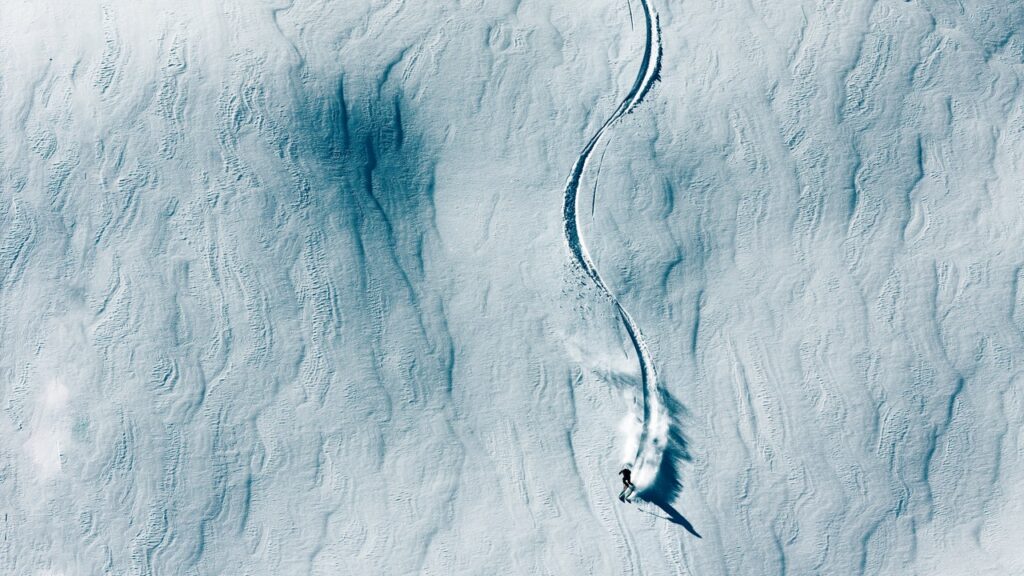But it’s that Thursday on the Marmolada glacier that lingers most. It feels like a blue-sky cleanse after days of intermittent snow that has left the little mountain huts laden with thick piles of the white stuff. At the panoramic terrace at the summit, after the expectant scrum of the gondola, there are selfie sticks and boom box strains of the Black Eyed Peas as we survey an epic panorama: the whole Dolomites laid out before us like an indescribably beautiful white diorama, as if art-directed for an irascible god. We are clearly not the only people who have waited most of the winter for this morning. But we are the only people who are with Favé, and she has a plan.
With snowboards on, we traverse sharply left and keep going, as the ant-like figures on the wide piste thin out behind us. Beneath us is a shimmering expanse of untouched snow like powdered sugar, winking in the spring sun; the odd shadow; the frozen Fedaia Lake far below. In the exquisite silence Favé can’t quite bring herself to do the whole guiding thing. Every fiber of her being is itching to go. So we ride: swooshing, gliding, carving, and hollering in the weightless happiness of it all, unable to make a false turn, each powdery stack inducing a subtly different shade of joy. At the bottom, more than six miles of floating ends at a little car park; the three of us hug without hesitation. The endorphins still tingling, we walk across a little bridge to the lakeside Rifugio Castiglioni Marmolada for a restorative radler. When we’re done, Aurelio Soraruf is waiting: a mountain old-timer with a snowmobile and a rope, ready to drag us, wakeboard-style, across the frozen Fedaia. And as we whiz across the flat whiteness and pass walking skiers who have also taken backcountry routes down the glacier, we encounter admiration rather than resentment. “Bella vita!” calls out one man. At the other side, as we strap on our boards to do it all again, Favé looks us up and down with that faintly amused half-smile of hers. “Spoiled, spoiled boys,” she says, finally. “Now we ski.”
Modern hotels
On the high Alpe di Siusi plateau, a crisp mod-Alpine style prevails at the Como Alpina Dolomites, as seen in the 60 rooms with wood headboards, the slouchy, hedonistic communal areas with pool tables and oversized chessboards, and the three restaurants, including the Northern Italian Trattoria Dell’Alpe. True to brand form, the Como Shambhala wellness area is the highlight, with its indoor-outdoor pool, NASA-designed Space Curl posture machine, and extensive treatments such as guided daily meditations in the sauna with essential oil infusions. Cortina d’Ampezzo is in the midst of a pre–Winter Olympics hotel boom, with classics like the Bellevue, Cristallo, and Ancora getting makeovers. The 22-room Hotel de Len, which means “of wood” in Ladino, is a new boutique in Japandi style by some of the team from Puglia’s much-loved Borgo Egnazia. Cool staffers in brown-checked shirts lead guests to dawn yoga sessions in the glassy top-floor spa or to aperitivi at the art-filled basement cocktail bar. They’re also happy to explain the mostly plastics-free hotel’s focus on sustainability, including the recycled woods that help reduce net carbon emissions.
Traditional stays
Rifugio mountain huts, generally family-owned inns with simple rooms and serious food, are a key part of Dolomiti culture. A prime example is Baita Dovich, originally built in 1963 on a quiet valley roadside near the Marmolada glacier. Co-owner Manuela Chizzali charms guests while her husband, Jacopo, works in the kitchen turning out elevated Tyrolean dishes like canederli bread dumplings with porcini mushrooms and local Tisoi cheese. Berghotel Passo Giau has an even more spectacular location, on a high mountain pass west of Cortina, and a more old-school vibe, with fossil-stone walls, crucifixes, and a wood-paneled dining room. Hotel Pordoi, outside Arabba, is a beautiful old stone building that serves hyperlocal vegetarian food at its Aidin restaurant, including a fabulous spinach-and-ricotta pie and a raspberry-compote kaiserschmarrn, the Austrian pancake dessert ubiquitous in the Dolomites. The quirkiest of all is the Rifugio Fuciade, cradled by mountains high above the Fassa Valley. The main building, which sits just beyond a little church, is a warren of small rooms crammed with ephemera like wood masks, accordions, and butter rollers that owners Emanuela and Sergio Rossi have acquired over the years.
Mountain restaurants
It’s hard to eat badly in the Dolomites. The locals tend to drink radlers and Trentino Lagrein red wines, often with a cheese-and-meat board. The terrace at Baita Daniel Hütte in Val Gardena is a great spot to look over the valley while sampling rare Tyrolean beef, while Masi Wine Bar in Cortina does excellent aperitivo. A standout lunch is the epic tomahawk steak in the very Alpine-trad Ciamberlain room at Baita Paradiso in San Pellegrino. We were served there by Marco Defrancesco, whose father owns the restaurant and whose uncle owns the cows that produce the meat as well as the Maso Ciamberlain vineyard, which made the 2021 Lagrein red. Back at Rifugio Fuciade, the family farm supplies ingredients in dishes like veal stew with polenta, cooked by the Rossis’ son Martino.
This article appeared in the January/February 2025 issue of Condé Nast Traveler. Subscribe to the magazine here.


